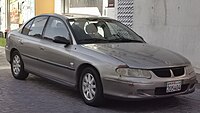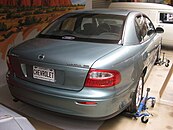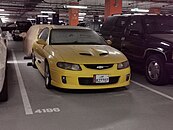Chevrolet Lumina
| Chevrolet Lumina | |
|---|---|
 Second-generation Lumina | |
| Overview | |
| Manufacturer | Chevrolet |
| Production | 1989–2001 |
| Model years | 1990–2001 |
| Body and chassis | |
| Class | Mid-size car |
| Layout | Front-engine, front-wheel-drive |
| Platform | W-body |
| Chronology | |
| Predecessor | Chevrolet Celebrity (sedan) Chevrolet Monte Carlo (coupe) Chevrolet Impala (Argentina) |
| Successor | Chevrolet Impala (sedan) Chevrolet Monte Carlo (coupe) |
The Chevrolet Lumina is a mid-size car that was produced and marketed by the Chevrolet division of General Motors from 1989 until 2001.
Background
[edit]The first generation of the Lumina replaced the Chevrolet Celebrity and Chevrolet Monte Carlo under a single nameplate; the mechanically unrelated Chevrolet Lumina APV minivan served as the successor for the Celebrity station wagon.[1] The model line was based on the front-wheel-drive GM10 platform (later designated the GM W platform), shared with Buick, Oldsmobile, and Pontiac. For 1995, the second-generation Lumina was introduced, serving as a substantial exterior revision of the previous generation (the two-door coupe was renamed the Monte Carlo[2]). For the 2000 model year, the Lumina was replaced by the Chevrolet Impala; the model line would retain the W platform through the 2016 model year.
Throughout its production, both generations of the Lumina were produced by General Motors Canada at Oshawa Car Assembly (Oshawa, Ontario). For markets outside of North America, the Chevrolet Lumina was derived from other large GM sedans. From 1998 to 2013, the Lumina was marketed in the Middle East and South Africa as a Chevrolet-badged version of the Holden Commodore produced in Australia.[3] From 2005 to 2006, GM Philippines sold the Lumina as a Chevrolet-badged version of the Buick Regal (sharing much of its body with its American counterpart).
First generation (1990)
[edit]| First generation | |
|---|---|
 1991–1994 Lumina sedan | |
| Overview | |
| Production | January 1989–August 25, 1994[4] |
| Model years | 1990–1994 |
| Assembly | Oshawa, Ontario, Canada |
| Designer | Irv Rybicki (1985) |
| Body and chassis | |
| Body style | 2-door notchback coupe 4-door notchback sedan |
| Layout | FF layout |
| Platform | W-body |
| Related | Buick Regal Oldsmobile Cutlass Supreme Pontiac Grand Prix |
| Powertrain | |
| Engine | 2.2 L LN2 I4 2.5 L Iron Duke I4 3.1 L LH0 V6 3.4 L LQ1 V6 |
| Transmission | 5-speed Getrag 284 manual 3-speed 3T40 automatic 4-speed 4T60 automatic 4-speed 4T60-E automatic |
| Dimensions | |
| Wheelbase | 107.5 in (2,730 mm) |
| Length | 1990 coupe: 198.4 in (5,039 mm) 1990 sedan: 197.6 in (5,019 mm) 1991–94 coupe & 1993–94 sedan: 198.3 in (5,037 mm) 1991–92 sedan & Z34 sedan: 199.3 in (5,062 mm) |
| Width | Coupe & Z34 sedan: 71.7 in (1,821 mm) sedan: 71.0 in (1,803 mm) |
| Height | Coupe & Z34 sedan: 53.3 in (1,354 mm) sedan: 53.6 in (1,361 mm) |
| Curb weight | 3,496 lb (1,586 kg) |

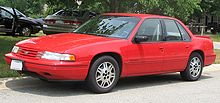
The North American Chevrolet Lumina was based on the mid-size GM10 platform, which was shared with the Pontiac Grand Prix, Oldsmobile Cutlass Supreme, and Buick Regal.[5] Although the Lumina became a popular seller, GM was widely criticized in the motoring press for being late to the game in introducing a direct aero-designed competitor to the Ford Taurus.[6] The "Lumina" name was considered by Ford in the pre-production stage of the Taurus.[7] Both body styles were available in base and sporty Euro trim, which was a successor to the Celebrity Eurosport.
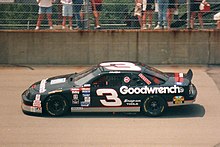
Airbags were not yet available at the time of introduction so seat belts were installed in the front doors as "passive restraints". These belts were connected to the upper and lower portions of the front doors, and could remain latched while allowing front passengers the ability to enter and exit the vehicle without removing them.[8] This technically satisfied US Government regulations concerning passive occupant safety requirements. GM was heavily criticized for the lack of airbags in Lumina, by 1993 the Ford Taurus, Honda Accord and Toyota Camry all came equipped with at least one front airbag.[9]
The coupe and sedan were installed with MacPherson front struts, while the rear suspension used Chapman struts and a transverse-mounted fiberglass leaf spring, borrowing an approach used from the Chevrolet Corvette (C4) rear suspension.[7]
The Chevrolet Lumina's first generation ended production in August 1994, making this the shortest-produced generation of the first-generation GM10 cars.[10]
NASCAR
[edit]In 1989, the Lumina became the nameplate under which Chevrolets were raced in NASCAR, more than a year before the model was available to the public.[11] As a result, NASCAR received many letters complaining about the unfair advantage of Chevrolet racing an "aluminum" car.[citation needed]
Lumina Z34
[edit]
Starting in 1990, Chevrolet offered a high-performance version of the Lumina, the Lumina Z34. It came standard with the FE3 sport suspension package, the 210 hp (157 kW; 213 PS) LQ1 V6 engine shared with the Lumina Euro 3.4 (sedan), the 5-speed Getrag 284 manual transmission, dual exhaust, and 4-wheel anti-lock brakes.
The Z34 also featured cosmetic changes to go along with the performance enhancements such as unique front and rear fascias, side skirts, a rear spoiler, a louvered hood, a unique steering wheel, and sport bucket seats, and an optional Bose stereo system.
Performance figures included a 0-60 mph (0–97 km/h) time of 7.1 seconds, a 1/4 mile (~400 m) time of 15.5 seconds, a (limited) top speed of 113 mph, and a lateral acceleration of 0.79 g (7.7 m/s²).[12] The optional Hydramatic 4T60-E automatic transmission lowered the horsepower rating to 200 hp (149 kW; 203 PS) and 0-60 times by .5 seconds.[13] The only paint colors available for the Z34 were white, red, black, gray, silver, and maui blue (added in 1993). In 1995, the Lumina Z34 was replaced with the Chevrolet Monte Carlo Z34.
Engines
[edit]- 1990–1992: 2.5 L (151 cu in) Iron Duke I4
- 1993: 2.2 L (134 cu in) 122 I4
- 1990–1994: 3.1 L (191 cu in) LHO V6
- 1991–1994: 3.4 L (207 cu in) LQ1 V6
Production
[edit]| Year | Sedans | Coupes | Sedan LQ1 | Coupe LQ1 (Z34) |
|---|---|---|---|---|
| 1990 | 278,311 | 45,783 | N/A | N/A |
| 1991 | 157,782 | 34,495 | N/A | 8,936 |
| 1992 | 188,557 | 33,490 | 5,623 | 13,016 |
| 1993 | 200,842 | 29,916 | 3,489 | 12,323 |
| 1994 | 75,753 | 10,866 | 1,234 | 4,478 |
| Total production[14] | 901,245 | 154,550 |
Second generation (1995)
[edit]| Second generation | |
|---|---|
 | |
| Overview | |
| Production | March 7, 1994 – April 26, 2001[4][15][16] |
| Assembly | Oshawa, Ontario, Canada |
| Designer | Chuck Jordan (1990, 1991) |
| Body and chassis | |
| Body style | 4-door notchback sedan |
| Layout | FF layout |
| Platform | W-body 1.5 Gen |
| Related | Chevrolet Monte Carlo Oldsmobile Cutlass Supreme Pontiac Grand Prix |
| Powertrain | |
| Engine | |
| Transmission | 4-speed 4T60-E automatic 4-speed 4T65-E automatic |
| Dimensions | |
| Wheelbase | 107.5 in (2,730 mm)[17] |
| Length | 200.9 in (5,103 mm) |
| Width | 72.5 in (1,842 mm) |
| Height | 1995–98: 55.2 in (1,402 mm) 1999–2001: 54.8 in (1,392 mm) |
| Chronology | |
| Successor | Chevrolet Lumina (VT) (Middle East) |


General Motors began the development of an updated Lumina in 1989, under chief engineer Norm Sholler, planned for a late 1992 launch. By 1991, a final body design was approved. Development eventually took longer than planned, delaying the launch by 18 months. The redesigned Lumina was unveiled at the Los Angeles Auto Show in January 1994 as a 1995 model. The 1995 Lumina received a rounded body, increasing its size, as well as an updated interior.[18] Unlike its other W platform counterparts, the Lumina retained the first-generation chassis. Replacing the Lumina two-door coupe was the resurrected Monte Carlo. The LH0 V6 was dropped in favor of the L82 V6, known as the 3100 SFI; the latter engine produced 20 more horsepower from the same displacement due to a revised intake manifold and cylinder heads.[19][20][21]
Initial trim levels consisted of base and LS; the latter replacing the "Euro" trim. Options included an electric sunroof, leather bucket seats, power windows, a power driver seat, and an AM/FM stereo with a CD player. This Lumina was available with police (code 9C3) and taxi packages, because the Chevrolet Caprice was discontinued after the 1996 model year. Production began on Monte Carlo coupes in February 1994 and March 7, 1994 for Lumina sedans at GM's Oshawa manufacturing plant, for a June 6, 1994 market launch for the 1995 model.[22]
The LTZ trim was introduced in 1996 for the 1997 model year because the Impala SS and Caprice were discontinued. Standard features included 16" brushed aluminum wheels, blackwall radial sport tires, sport tuned suspension, a 3.1 L V6 rated at 160 hp (119 kW) and 185 lb⋅ft (251 N⋅m) or an optional 3.4 L V6 rated at 215 hp (160 kW) and 220 lb⋅ft (298 N⋅m) of torque, a rear spoiler, restyled front and rear body clips (resembling the Monte Carlo Z34), a tachometer, and a floor-mounted shifter.
For 1998, the 3.4 L V6 was replaced by the 3800 Series II which produced 200 hp (149 kW) and 225 lb⋅ft (305 N⋅m) of torque. Despite its increased torque, the 3.8 L LTZ demonstrated slightly worse performance due to its lowered horsepower, with 0-60 mph (0–97 km/h) times of 7.5 seconds (as opposed to 7.2 seconds for the LQ1) and 1/4 mile (~400 m) times of 15.7 seconds (as opposed to 15.5 seconds for the LQ1). The car has a computer-limited top speed of 107 mph (172 km/h) and the rev limiter kicks in at 5,800 rpm for the 3.8 L (rev limiter is at 7,000 rpm for the 3.4 L LQ1).
Also in 1997, the 1998 model year Luminas received second generation airbags. The front-wheel-drive Chevrolet Impala was introduced as a replacement for the Lumina in 2000, although GM produced 2001 model year Luminas to be exclusively sold for rental fleets. Retail sales of the Lumina ended in Canada in 1999, with the United States following a year later. Fleet production ended on April 26, 2001. In some Asian countries, the Lumina continued as a rebadged Buick Century/Regal.
Trim levels
[edit]Throughout its life cycle, the second generation Lumina was available in three trim levels:
Base (1995–2001): The most popular Lumina had a standard front row bench seat with seating for six passengers, power locks, tilt steering wheel, dual airbags, and air conditioning. Base models were equipped with fifteen-inch steel wheels with wheel covers.
LS (1995–1999): The mid-level trim models included aluminum wheels, optional dual-zone temperature controls, power windows (optional on Base), tachometer, higher-end stereo with GM's Delcolock, anti-lock brakes, remote keyless entry system, upgraded seats, and an optional 3.4 L DOHC engine (1995-1996).
LTZ (1997–1999): The top-of-the-line Lumina included alloy wheels, a choice of the 3.1 L V6 engine, 3.4 L DOHC engine (1997), and the 3.8 L V6 engine (1998-1999), power driver seat, dual-zone climate control and leather with the option for deluxe cloth. A center console was standard on LTZ (optional on LS). Exterior differentiation included the front end, trunk lid, and taillights from the Fifth Generation Chevrolet Monte Carlo.
Engines
[edit]- 1995–1999 3.1 L (191 cu in) L82 V6
- 1995–1997 3.4 L (207 cu in) LQ1 DOHC V6
- 1998–1999 3.8 L (231 cu in) L36 V6
- 2000–2001 3.1 L (191 cu in) LG8 V6
Production
[edit]| Year | Total | LQ1 | L36 |
|---|---|---|---|
| 1995 | 264,688 | 15,998 | N/A |
| 1996 | 224,553 | 2,054 | N/A |
| 1997 | 234,626 | 7 | N/A |
| 1998 | 208,627 | N/A | 16,679 |
| 1999 | 139,098 | N/A | 13,869 |
| 2000 | 37,493 | N/A | N/A |
| 2001 | 42,803 | N/A | N/A |
| Total production | 1,151,888 |
Marketing
[edit]Chevrolet signed a deal with The Walt Disney Company to make the 1990 Lumina the official car of the Disney-MGM Studios park, which opened in 1989.[23] As part of this promotion, characters from Disney films were featured in early advertisements for the Lumina.
Safety
[edit]Insurance Institute for Highway Safety (IIHS)
[edit]| Moderate overlap frontal offset | Good |
| Small overlap frontal offset | Not Tested |
| Side impact | Not Tested |
| Roof strength | Not Tested |
NHTSA
[edit]| Year | Frontal Driver | Frontal Passenger | Side Driver | Side Passenger | 4x2 Rollover | 4x4 Rollover |
|---|---|---|---|---|---|---|
| 1995 | Not Rated | Not Rated | Not Rated | Not Rated | ||
| 1996 | Not Rated | Not Rated | Not Rated | Not Rated | ||
| 1997 | Not Rated | Not Rated | ||||
| 1998 | Not Rated | Not Rated | ||||
| 1999 | Not Rated | Not Rated | ||||
| 2000 | Not Rated | Not Rated | ||||
| 2001 | Not Rated |
Holden-based models
[edit]| Holden-based Lumina | |
|---|---|
 2001–2002 Chevrolet Lumina SS (VX) sedan | |
| Overview | |
| Manufacturer | Holden (General Motors) |
| Also called | Holden Commodore (Australia & New Zeland) Chevrolet Omega (Brazil) Pontiac G8 (United States) Vauxhall Monaro (United Kingdom) Vauxhall VXR8 (United Kingdom) |
| Production | 1998 – 2013 |
| Assembly | Elizabeth, South Australia (Holden Elizabeth Plant) |
| Body and chassis | |
| Body style | 2-door coupé 2-door coupé utility 4-door sedan 5-door station wagon |
| Layout | Front-engine, rear-wheel-drive |
| Platform | GM V platform (1998–2006) GM Zeta platform (2006–2013) |
| Related | Holden Caprice Holden Commodore Holden Monaro |
| Chronology | |
| Predecessor | Chevrolet Lumina (Middle East) |
| Successor | Chevrolet Malibu Chevrolet Camaro |
The Australian GM subsidiary, Holden, manufactured a third and fourth generation of the Chevrolet Lumina based on the rear-wheel-drive Commodore (VX, VY, VZ, and VE series).
Overview
[edit]Since the late 1990s, Holden Commodores were sold as the Chevrolet Lumina in the Middle East and South Africa in sedan, wagon[32][33] and Ute coupé utility[34] configurations. A coupe version based on the Holden Monaro was also sold in the Middle East as the Chevrolet Lumina Coupe.
In some Middle Eastern markets, the 3rd gen Commodore-based Lumina acted as the successor to the 2nd gen W-Body Lumina.
Export sales finished in 2013[citation needed]. The Lumina was indirectly replaced in some markets by the slightly smaller Chevrolet Malibu; and the Chevrolet Camaro for the 2-door coupe and SS variants.[35]
Markets
[edit]In Arabia, the Lumina was offered in four different trims: LS (Omega), LTZ (Berlina), S (SV6) and SS (SS). The LTZ and S came standard with a 3.6 L Alloytec V6 and a six-speed automatic transmission for the S and four-speed for the LTZ, while the SS came standard with a 6.0 L l76 V8 with the option of active fuel management. A six-speed manual was standard with the option of a six-speed automatic on the SS. The LTZ was the luxury model, while the S and SS models focused on sportiness. Exports to the Middle East ceased in 2011.[36]
Lumina models sold in South Africa dropped the V6 engine in favour of 6.0 litre V8 engine mated to a six-speed manual or automatic. Fuel injection and a 10.4:1 compression ratio help contribute to a max power output of 270 kW (362 hp) at 5,700 rpm, and a max torque of 530 N⋅m (391 lb⋅ft) at 4,400 rpm for vehicles equipped with the manual. Automatic cars make 260 kW (349 hp) at 5,800 rpm and 517 N⋅m (381 lb⋅ft) at 4,400 rpm. All cars were equipped with Brembo brake calipers and a ZF limited-slip differentials. The car received updates for the 2011 model year. These changes were introduced to coincide with the release of the VE Series II Commodore. Changes included revised bumpers, there is a chrome moulding above the number plate on the boot lid, refreshed alloy wheel designs and the Holden IQ system. Also the SSV model was introduced.[37] The Holden Ute was sold as the Lumina Ute in South Africa and has the same equipment as the sedan. South African exports ceased in 2013.
Other Commodores sold under the bowtie brand were Holden Calais based Chevrolet Omega in Brazil; and High-performance models powered by Chevrolet V8 engines, including the high specification Chevrolet SS based on the VF Series, exported to the United States.
-
Chevrolet Lumina LS (VX)
-
Chevrolet Lumina LS (VX)
-
Chevrolet Lumina SS Coupe
-
Chevrolet Lumina SS Coupe
-
Chevrolet Lumina SS (VY)
-
Chevrolet Lumina SS (VE)
Philippines model
[edit]| Philippine-market Lumina | |
|---|---|
 A Chinese market Buick Regal on which the Philippine market Lumina is based on | |
| Overview | |
| Also called | Buick Regal (China and North America) |
| Production | 2005–2006 |
| Model years | 2005–2006 |
| Assembly | China: Shanghai, Shanghai GM |
| Body and chassis | |
| Body style | 4-door sedan |
| Layout | FF layout |
| Platform | W-body 2nd Gen |
| Powertrain | |
| Engine | 2.5 L LB8 V6 |
| Chronology | |
| Predecessor | Opel Omega |
| Successor | Chevrolet Malibu |
The Chinese-built Buick Regal was sold in the Philippines from 2005 to 2006 as the Chevrolet Lumina. GM had withdrawn from the Philippines in 1985 along with Ford, finding the political and economic situation there untenable. This left only Nissan and Mitsubishi operating in the Filipino market. In 1997, GM returned with the Opel brand, and introduced the Opel Vectra, Opel Omega, and, shortly thereafter, the Tigra and Astra. In 2000, Chevrolet returned with the Chevrolet Suburban and Chevrolet Savana, with GM dealerships being rebranded as GM AutoWorld. However, Opel struggled in the Filipino market, with Japanese automakers accounting for 80% of the total market by the year 2000. After the discontinuation of the Omega, the Vectra became Opel's largest sedan offering in the market. The Vectra struggled against rivals like the Nissan Cefiro, Honda Accord and Toyota Camry. GM withdrew the brand in 2003, leaving them without a car in the mid-size segment. In 2005, GM introduced the Chevrolet Lumina as a competitor to the growing mid-size sedan market.[38]

The only engine offered was a 2.5 liter V6, producing 152 hp and 154 lb-ft of torque. Mated to the Lumina's engine was a four-speed automatic. It had a top speed of 173 km/h and a 0-100km/h time of 12.8 seconds. The exhaust system was equipped with a Euro 2 standard catalytic converter.
Safety features included a four-wheel disc brake system with ABS, an onboard vehicle diagnosis system, a tire pressure monitor, integrated turn signal/headlight housing, five seatbelts and dual front airbags. The Lumina's body featured an integrated steel body structure with side impact protection. To prevent theft, the Lumina featured an engine immobilizer and a central locking system.
Standard features included keyless entry, an eight-way power-adjustable driver's seat, remote trunk opener, power side mirrors, and a tilt adjustable leather-wrapped steering wheel with hydraulic power steering. The interior also featured leather seats, faux wood trim, a rear armrest, electronic climate control system, and a six speaker CD system.[39] It was only available in three colors: white, silver, and black.
The Lumina is one out of two rebadged Chinese-market Buicks sold in the Philippines, the other being the Buick GL8-based Chevrolet Venture. Both are sourced from Shanghai GM. The car cost around P1.290M at the time and was quite a bit larger than the Vectra, measuring 20 inches longer and around 5 inches wider. This made it the largest car in its class, larger and wider than its main competitors, the Honda Accord and the Toyota Camry. The car was praised for being comfortable, spacious, and well-equipped, yet its design was criticized for being a "bit too bland".[40]
The Lumina was short-lived. It was discontinued in 2006, with production of the Chinese market Regal halting in 2008. Sales were poor, making the Lumina a rare car in the Philippines. In 2013, Chevrolet Philippines introduced the Chevrolet Malibu as the successor to the Lumina. It would eventually be discontinued in 2021.
References
[edit]- ^ "Chevrolet Lumina". Automotive.com. Archived from the original on 2016-02-03. Retrieved 2016-01-29.
- ^ "Chevrolet Monte Carlo model history". NADAguides. Archived from the original on 2016-04-07. Retrieved 2016-01-29.
- ^ Nunez, Alex. "Chevrolet Special Vehicles debuts in Middle East with the CR8". Autoblog. Retrieved 2016-01-29.
- ^ a b "Lumina reaches end of the line". Automotive News. April 30, 2001.
- ^ "Curbside Classic: 1990-94 Chevrolet Lumina – Not Quite Saving The Best 'Til Last". Curbside Classic. Retrieved 2016-01-29.
- ^ Krebs, Michelle (1996-06-23). "Behind the Wheel: Ford Taurus G vs. Chevrolet Lumina; Some Cheap Shots In the Price Fight". The New York Times. ISSN 0362-4331. Retrieved 2016-01-29.
- ^ a b Snitkoff, Edward. "Curbside Classic: 1986 Ford Taurus/Mercury Sable – At This Moment, You Mean Everything". Curbside Classics. Retrieved 19 October 2015.
- ^ "Seatbelts In The 1990s Were Completely Absurd". Jalopnik. 2017-01-31. Retrieved 2022-07-12.
- ^ "Why didn't we recommend the Chevy Lumina to Brenda? Safety concerns, that's why". Car Talk. 1993-03-01. Retrieved 2022-07-12.
- ^ "New Chevrolet Lumina". thenewautos.net. Archived from the original on 2016-02-02. Retrieved 2016-01-29.
- ^ "Lumina To Make Its Nascar Finale". tribunedigital-dailypress. Archived from the original on 2016-02-04. Retrieved 2016-01-29.
- ^ Antoine, Arthur St (2021-04-14). "Tested: 1991 American Performance Sedan Comparison". Car and Driver. Retrieved 2022-07-12.
- ^ Bows, Autumn (2021-01-12). "A Detailed Look Back At The Chevrolet Lumina Z34". HotCars. Retrieved 2022-07-12.
- ^ The Encyclopedia of American Cars, 2006 Edition
- ^ "Historical Newspapers". Newspapers.com.
- ^ "1995 Chevrolet Lumina Vehicle Information Kit" (PDF). gmheritagecenter.com. 10 April 1995. Retrieved 4 December 2019.
- ^ "1998 Chevrolet Lumina". The Old Car Manual Project Brochure Collection.
- ^ Rosa, Mike (2014-01-05). "Design Notes: 1995 Chevrolet Lumina Sedan". Autos of Interest. p. 2. Archived from the original on 2015-01-13.
- ^ Lienert, Paul. "Big Three Hope Makeovers Will Win Converts". Chicago Tribune.
- ^ Levin, Doron P. "Fast-Paced World Of Family Sedans Passing GM By". The New York Times.
- ^ Dean, Paul (13 January 1994). "In 2000: Future Stock: Sorry, cars won't fly or walk on water. And they'll still slurp up gas. But look for more luxury, lighter frames and better value". Los Angeles Times.
- ^ "Chevrolet Rolls Out Its Comeback Cars: Monte Carlo, Lumina Lead Mid-Sized Assault". Automotive News. February 21, 1994.
- ^ Okulski, Travis (30 January 2013). "The 1990 Chevrolet Lumina Is The Official Car Of Disney-MGM Studios". jalopnik.com.
- ^ "IIHS-HLDI: Chevrolet Lumina". Iihs.org. Retrieved 2013-04-04.
- ^ "1995 Chevrolet Lumina 4-DR. | Safercar - NHTSA". Safercar.gov. Retrieved 2013-04-05.
- ^ "1996 Chevrolet Lumina 4-DR. | Safercar - NHTSA". Safercar.gov. Retrieved 2013-04-05.
- ^ "1997 Chevrolet Lumina 4-DR. | Safercar - NHTSA". Safercar.gov. Retrieved 2013-04-05.
- ^ "1998 Chevrolet Lumina 4-DR. | Safercar - NHTSA". Safercar.gov. Retrieved 2013-04-05.
- ^ "1999 Chevrolet Lumina 4-DR. | Safercar - NHTSA". Safercar.gov. Retrieved 2013-04-05.
- ^ "2000 Chevrolet Lumina 4-DR. | Safercar - NHTSA". Safercar.gov. Retrieved 2013-04-05.
- ^ "2001 Chevrolet Lumina 4-DR. | Safercar - NHTSA". Safercar.gov. Retrieved 2013-04-05.
- ^ "Chevrolet Lumina Wagon in "Salem's Lot"". Internet Movie Cars Database.
- ^ "Chevrolet Lumina Wagon in "طاش ما طاش (No Big Deal)"". Internet Movie Cars Database.
- ^ "Chevrolet Lumina Ute in "Min søsters børn i Afrika"". Internet Movie Cars Database.
- ^ "GM Middle East, Brazil Give Zeta-Based Chevrolet Lumina The Axe". GM Authority.
- ^ Dowling, Joshua (14 November 2011). "Holden loses another Commodore export deal". carsales.com.au. Archived from the original on 2 December 2013. Retrieved 28 March 2012.
- ^ "Refreshed 2011 Chevrolet Lumina". South African Car Fan. 31 March 2011. Archived from the original on 8 February 2013. Retrieved 22 August 2013.
- ^ Stopford, William (November 21, 2018). "Obscure Rebadges From Around The World: Part 6". Curbside Classic. Retrieved May 26, 2021.
- ^ "GM illuminates midsize sedan market with new Chevy Lumina - Auto News". AutoIndustriya.com. February 22, 2005. Retrieved May 26, 2021.
- ^ de los Reyes, Manny N. (July 6, 2005). "Driving the Chevrolet Lumina". Philstar.com. Retrieved May 26, 2021.

